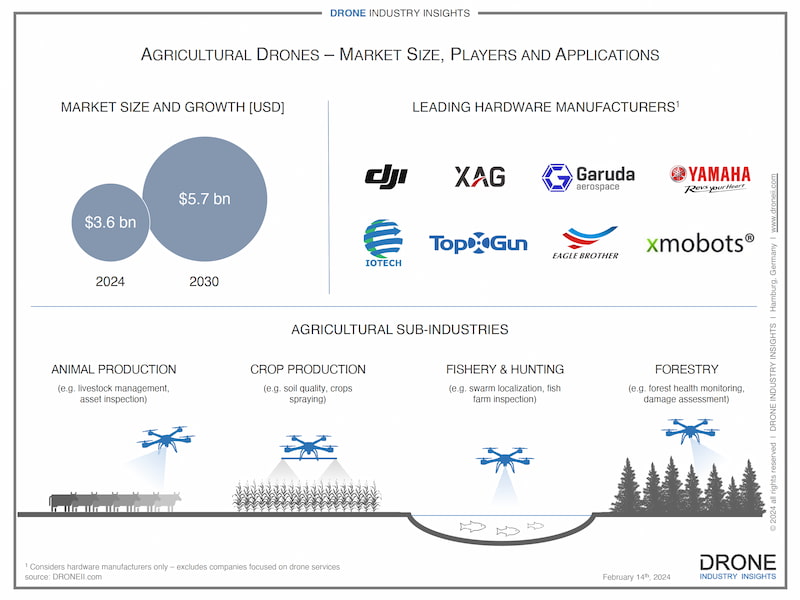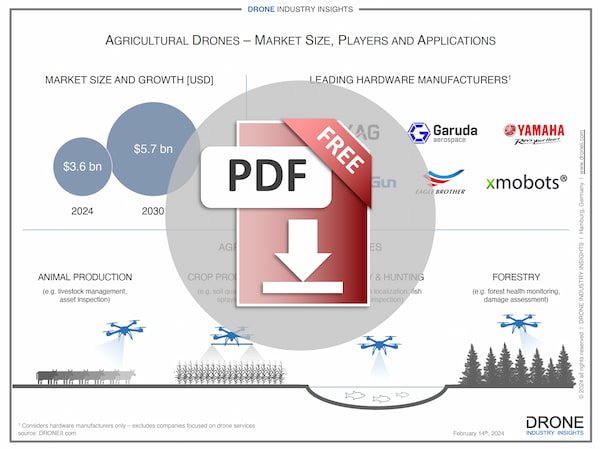The Market for Agricultural Drones
Agriculture remains a top 3 industry for drone technology, and agricultural drones represent a market that is set to grow from US$3.6 billion in 2024 to US$5.7 billion by 2030. And yet the term “agricultural drone” can refer to dozens of types of operations in various types of contexts and locations. From grazing lands to crop fields and from fish farms to dense forests, there are unique and exclusive benefits of using drones in each of these agricultural sub-industries. Our second-ever industry-specific report focuses on agricultural drone applications, and here is a glimpse of the insights found within.
The Use of Drones in Agriculture
Agricultural drones add value by providing access to aerial data quickly, flexibly, and in very good quality. While this is true for all verticals, in agriculture it brings an additional safety feature: there is no one around who could get hurt if the drone crashes (vs for example construction where likely people are operating below). Moreover, it is perhaps agriculture more than any other vertical where operations span for hundreds or even thousands of square kilometers under very hot, humid, or mountainous terrain, and yet every meter is important. It is here that agricultural drones bring a uniquely unbeatable level of speed, safety, and operational efficiency.
Drones help farmers collect data and dispense resources (e.g. seeds, pesticides). This helps save resources (time, and costs), increase safety, and improve quality. Moreover, agricultural drones enable new and incomparably efficient ways to carry out tasks like planting seeds, locating animals, or spraying fields. These are things that humans have arduously carried out manually for thousands of years or left entirely up to fate (in the case of field spraying before modern agriculture).
Among the new and unique outputs that agricultural drones provide, there are aerial pictures or 2D maps, NDVI maps/mosaics, or IR maps. In some cases, 3D surveys created by drones also help to better understand terrain structures, slopes, and anything else that might cause an uneven territory. Next to static images, live video feeds also help farmers check and manage land, inventory, workforce, and livestock.
For a better understanding of all these activities, here is a look at how drones are used in various sub-industries of agriculture.
Agricultural Drones Used for Livestock
The use of drones for livestock management is centered around finding and counting animals within a defined area. This is where new technologies like computer vision can help identify animals and count them regardless of whether they move (a task that is much more complicated for humans or other alternatives). Drones also allow operators to identify sick or dead animals, which helps contain or at least limit the spread of diseases.
And it is not only with the animals themselves that a drone can help livestock management. When it comes to [physical] containment, a drone can also carry out detailed inspections of fences over enormous distances, which not only helps keep farm animals in but also potential predators out.
Agricultural Drones Used in Crop Farming
Naturally, many people think about plants and vast crop fields when they think of agriculture. In this context, it is clear that drones can fly over and photograph thousands of square kilometers much faster than any human with any other vehicle could. However, thanks to technology, agricultural drones can also carry out incredibly sophisticated tasks such as: surveying soil quality/composition, sensing plant stress and deficits in nutrition, detecting pests, and spraying pesticides, insecticides, and the optimal amount of water and fertilizer.
All of this enables farmers to act quickly and with a lot less effort than it would normally take to detect and react to e.g. a pest infestation. In this particular case, the risk of spreading can be mitigated immediately and limited to a small area. This saves time and money while increasing crop yield given that less biomass will fall victim to the pest. It also optimizes pesticide usage and crop sprays through early detection.
Want to Know More About Agricultural Drones? Check Out Our New Drones in Agriculture Market Report!
Drones in Agriculture Market Report
• Extensive 79-page report focused on agricultural drones
• Dedicated chapter on market dynamics, also including UNIT SALES!
• Chapter highlighting agricultural drone applications including case studies
• Ranking of top manufacturers for drones used in agriculture
• Special insights on regulation and industry trends
Agricultural Drones Used for Fishery & Hunting
In fishery, drones are relatively new and are being used to help find fish swarms. They allow trawlers to navigate to the richest fishing grounds to optimize the use of their time, fuel, and fishing resources. When it comes to fish that are already contained (i.e. fish farms), drones can also be used for asset inspections in a similar way to the livestock management mentioned earlier. Finally, the feeding of fish or shrimp with rice paddies is also on the rise on the list of drone-based agricultural applications.
When it comes to hunting, there are two important points to be made. The first is that, from a technical perspective, finding animals with IR cameras certainly works wonders. However, the second and more important point is that this is deemed illegal in many countries. So, while there are no official real-life cases for drone-based hunting, a drone can certainly play a unique role in terms of efficiency and safety in the unique scenarios where for example an animal may need to be hunted (e.g. to end the suffering of a wounded animal).
Agricultural Drones Used in Forestry
In forestry, drone technology is used quite similarly to crop production. This entails health monitoring of forests, including their growth, stress, yield calculation, and detection of fires or pests among other risks. However, in contrast to crop production, 3D models of vegetation are more common, and this requires a more sophisticated technology stack.
Next to health monitoring, drones can help count trees, determine species, and even calculate the volume of a forest. And there are also cases where a drone helps identify dead/dying trees that may fall into powerlines or train tracks. All of this helps foresters to better manage their “assets” more effectively and with a more holistic approach. And in terms of the speed, accuracy, and safety that drones offer, it is perhaps unfair and unnecessary to even compare them with any other alternative.
Common Types of Agricultural Drones and Equipment
Multirotors still account for a vast majority of drones used in Agriculture. For remote sensing tasks (e.g. inspections, surveying), multirotors allow for data to be captured very flexibly and quickly. Simply being able to stop mid-air and have a closer look at things is a great value added to the daily farm work routine. Nevertheless, fixed-wing agricultural drones are increasingly popular to effectively cover large areas. This type of drone platform can create coherent and reproducible results by flying repetitively over the same pre-programmed routes.
To visualize things that are invisible to the human eye, equipment such as EO cameras were initially modified to capture NIR images. Nowadays, multispectral cameras are used exclusively to capture images on different channels, making it much easier to create for example NDVI images. As far as other common types of equipment go, dispensing and spraying devices are also very popular. Additionally, robotic arms are being introduced to autonomously pick fruits.
Conclusion: Agricultural Drone Companies and Services
Not surprisingly, some of the leading manufacturers of agricultural drone hardware are located in countries that are often considered manufacturing powerhouses. These include DJI (China), XAG (China), Garuda Aerospace (India), IO TechWorld (India), TopXGun (China), Eagle Brother (China), and Xmobots (Brazil). However, there are also plenty of companies offering full drone service solutions for agriculture, and this includes many of the top drone service providers.
It is essential to recognize that agricultural drones serve as highly efficient tools within the broader agricultural toolbox. They are not game-changers in the traditional sense, nor do they completely replace existing methods. Instead, they optimize workflows by complementing and enhancing the capabilities of the agricultural sector. The adoption of drone technology in agriculture has been gradual. This has been partly due to the conservatism of traditional farming practices that have been handed down through generations. But it has also been because of regulatory constraints, such as those limiting beyond visual line of sight (BVLOS) operations, which have restricted scalability.
All in all, despite some challenges, the outlook for the agricultural drone market remains positive. The sector is on a growth trajectory, with substantial potential for future expansion. This growth is underpinned by the increasing awareness about the unique advantages of using drones for agriculture. As regulations evolve and technology advances, drones are set to play an increasingly significant role in driving efficiency and productivity in agriculture.
Download our FREE Agricultural Drones Infographic
The “Agricultural Drones Infographic” highlights the top ways in which drones are used for agriculture as well as the top agricultural drone manufacturing companies and a market size forecast until 2030.

Before working with drones, Ed acquired vast experience in Communications and Diplomacy. He holds a Master’s in International Relations, Bachelor’s in Economics & Philosophy, and has lived in 7 countries.
- 1 The Use of Drones in Agriculture
- 2 Agricultural Drones Used for Livestock
- 3 Agricultural Drones Used in Crop Farming
- 4 Want to Know More About Agricultural Drones? Check Out Our New Drones in Agriculture Market Report!
- 5 Agricultural Drones Used for Fishery & Hunting
- 6 Agricultural Drones Used in Forestry
- 7 Common Types of Agricultural Drones and Equipment
- 8 Conclusion: Agricultural Drone Companies and Services





